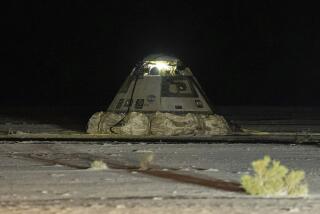Rain Delays Landing, May Divert Shuttle to California
KENNEDY SPACE CENTER, Fla. — Rain and fog in Florida kept the luckless shuttle Columbia from landing Thursday, and NASA said conditions might not be much better today, raising the possibility that the ship might be diverted to California.
“OK, well, I guess it’s one of those things,” said Cmdr. Robert L. Gibson when informed of his craft’s predicament.
Officials do not want a landing in California because the extra time needed to get the ship back to the launch site could jeopardize plans to ready Columbia for flight again March 6 to examine Halley’s comet with the largest telescope ever carried into orbit.
Tight Schedule
However, launch director Gene Thomas said a March 6 blastoff would not be ruled out even if Columbia is forced to California. He said a tight schedule would just be made tighter.
Never in the 23 previous flights has a shuttle had so much trouble getting up and back in the same mission. Columbia had six official launch delays and only two shuttles have been waved off from Florida landings because of weather.
Columbia’s planned landing on Thursday was canceled just 19 minutes before Gibson was to trigger rocket engine firings that would drop the craft out of orbit.
Weather forecasts for Thursday’s landing had been favorable. In the pre-dawn hours, however, rain-filled clouds and dense fog moved over the Florida spaceport.
Chief astronaut John Young, aboard a weather reconnaissance plane over the area, reported that the overcast and fog were so thick that he could not see the lights at the end of the runway.
Must Avoid Rain
Flight director Gary Coen said the shuttle must avoid flying through rain because high-speed impact with droplets could erode the fragile heat-protection tiles on the craft and possibly throw it out of control.
This morning’s forecast called for scattered clouds with no rain but the chance of some ground fog. Air Force weathermen said the outlook is worse for Saturday because a low-pressure area was expected to move toward the spaceport.
Despite the marginal weather forecast, controllers told Gibson and his six crewmen to plan to descend for a Kennedy Space Center landing at 4:12 a.m. PST today, saying a final decision would be based on pre-dawn weather conditions.
If the weather in Florida is unsatisfactory, controllers will decide whether to divert Columbia to Edwards Air Force Base for a landing 90 minutes later or to try to land at the Kennedy Space Center Saturday.
A landing at Edwards would set back preparations for Columbia’s March flight by at least five days because it would take that long to ferry the ship back to the Kennedy Space Center.
25 Days Behind Schedule
Because Columbia’s blastoff last Sunday was 25 days behind schedule, ground crewmen already face a tight schedule to get the ship ready to fly again in March. That was one of the reasons why the National Aeronautics and Space Administration wanted to have the ship land at the Kennedy Space Center Thursday, a day earlier than originally planned.
The March 6 launch date for Columbia is based on the optimum time to study Halley’s comet. The good viewing opportunities end March 10.
Gibson, Charles F. Bolden, George D. Nelson, Steven A. Hawley, Franklin R. Chang-Diaz, RCA engineer Robert J. Cenker and Rep. Bill Nelson (D-Fla.) made use of the extra time in orbit by photographing Halley’s comet with a 35-millimeter camera and running other experiments.
More to Read
Sign up for Essential California
The most important California stories and recommendations in your inbox every morning.
You may occasionally receive promotional content from the Los Angeles Times.










